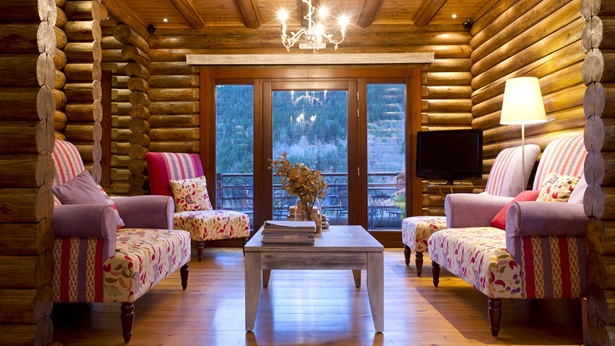How to Make the Most of a Log and Timber Home Show
Those attending a log and timber home show for the first time share an excitement that is palpable. One can see the enthusiasm on their smiling faces as they enter the show, full of confidence and ready to make their dream home a reality.
Unfortunately, many of these same faces can reflect dismay and weary confusion at the end of their first day. With a dizzying array of log profiles, styles and species to choose from, a full schedule of workshops that cover everything from financing and foundations, to turnkey construction and maintenance, attendees can quickly become overwhelmed by the sheer amount of information.
Often what they thought they knew or what they thought they liked, is suddenly undermined by exposure to new information or a different look of log and timber home they hadn’t contemplated.
Fearful of making the wrong choice or appearing ignorant of construction techniques or technologies, attendees can lapse into stunned silence and their eyes can glaze over as one log and timber home producer after another extols on the virtues of how their wood is far better than their competitor’s.
How can you avoid this emotional and mental overload? In an attempt to make your show experience as enjoyable and as productive as possible, the Log and Timber Homes Council has come up with some suggested strategies to spend your time efficiently.
Narrow the Field to Log and Timber Homes Council Members
You can narrow the field of competent companies by limiting your choices to the membership of the Log and Timber Homes Council. Why? Because these companies offer peace of mind when it comes to making your dream home true. All have adopted policies designed to protect your investment, as well as assist everyone involved in this project.
All Log and Timber Homes Council’s members must:
- Abide by a strict code of ethics
- Grade their logs and timbers by third party agencies to ensure quality
- Provide construction manuals to ensure homes are built to meet building codes
- Sponsor scientific studies that advance log building technologies
- Provide FREE information through the Buyers’ Guide to help consumers make smart choices
- Print out a list of Log and Timber Homes Council members
Depending on where a log and timber home show is held, a council member may be represented by a local builder/dealer who lives in that market.
Give Yourself Plenty of Time
To make the most of the show, give yourself as much time as possible. Plan on arriving early and leaving late each day of the show. Exit surveys reveal most attendees wished they had more time to see everything and everyone. Buying and building a log and timber home is likely to be one of the biggest investments of your life. So this extra time is certainly worth your investment. You want to give yourself as much time as possible to learn as much as you can. Arrive at the event when it opens and plan on staying the entire day. If you are traveling some distance to attend the show, consider getting a hotel room so that you’ll be well rested for the entire three-day show. Take regular breaks as well. This shouldn’t be a grueling process.
Determine Where You are in the Process
Whether you’ve been dreaming about having your own log and timber home for decades or it’s a new found passion, it’s likely that no two people needs will be the same. If you’ve been reading the Log and Timber Homes Council’s Buyers Guide consistently, have compiled a photo scrapbook of amenities, have developed a floor plan and accumulated an extensive material specifications checklist, you are much farther along this path. It’s likely that you can jump right into shopping log and timber home producers that offer the look that you like.
In contrast, if you’re just starting your research, it may be some time before you decide on a log and timber home producer or builder. Your time may be better spent learning all you can in the workshops or seminars, with tours around the show floor to determine which kind of log style you find most aesthetically appealing.
Make a Plan
Only by setting goals can you know if you’ve achieved them. That’s why we encourage you to make a plan of what you need to accomplish and why. This can include a list of questions you want to ask each producer you may want to do business with.
You and your spouse may have diverse areas of interest or expertise and we encourage you to take advantage of that. In this instance, you may want to split up to gather more information. For instance, one could be concentrating on deciphering which company offers the profile the couple likes best, while the other could be looking at financing, decorations and furnishings. You should also attend those workshops where you lack knowledge. You can meet for lunch or at specific break times to discuss what you have discovered so far. You can then get back on the floor for more research.
If you have children, you may want to make arrangements for them for the day. Log home shows are not ideal for entertaining children. They soon become bored and can pull your focus away from your research. It’s fun and important to get the entire family involved in the planning process but leave the show floor to the parents, who need time to do their research.
Determine Your Budget
You can’t shop for a conventional home without knowing how much you can afford, nor can you build a log or timber frame home without establishing a realistic budget. If you haven’t worked with a mortgage lender before the show to determine your budget, we suggest your first visit should be with those exhibitors who offer financing.
Without a good understanding of your finances, you will not be able to direct your energies toward a realistic log and timber home you can afford. Later in the process you can work with your lender to establish more firm figures. But a ballpark budget will allow you to compare companies and their log and timber home packages.
We encourage you to share your budget with potential log and timber home producers. Keeping it a secret won’t earn you a lower price — it will only get you ignored. Many log and timber home producers steer away from people unwilling to share their budget because they risk wasting time on projects buyers can’t afford. Producers refer to this as champagne dreams but only beer pocket money.
Let Profile Preference Guide You
As you will discover by visiting with the exhibitors, there are a wide variety of log wall styles to choose from. There are different log profiles, diameters, corner styles, insulating systems, fastening and sealing techniques. And upon further investigation, you’ll find that beyond sharing the look of logs, the homes offered by producers today share only a few similarities. So how do you tell which wall style is right for you? Just like with deciding on the design of a conventional home, it’s often a matter of personal preference.
Once you decide on an exterior and interior look that you like, you’ll narrow the field of possibilities at the show quite dramatically. If it’s dovetail that you want, don’t be afraid of walking up to a exhibitor and asking if they offer it. You don’t want to waste your time talking to a company that doesn’t offer the aesthetic look that you like.
Weigh Quality, Quantity and Service
Once you have narrowed your search, visit with each of them and obtain their sales materials. The brochures, plan books, catalogs and videotapes should answer important questions and explain each company’s business philosophy.
You should also compare quality, quantity and service offered by each company. The quality refers to the species of logs, whether the logs or timbers are milled or handcrafted, air or kiln dried. These issues can affect the quickness and ease of construction, as well as maintenance issues over the life of the home.
One way to compare packages is to ask the producer, “What is not included?” A manufacturer should be able to give you a complete list of all the materials included in their package. No single package deal is right for everyone. You must choose the one that best meets your needs. Obviously, the more the manufacturer includes in terms of finished products and materials, the more expensive the package will be.
Perhaps most importantly, one must also weigh customer service. Most people are shopping for a product, when they should really be shopping for a relationship. Are the homes really going to differ that much in cost? Trees are trees. Logs are logs. What you should be looking for is someone you can trust.
How do you separate reputable salespeople from questionable ones? A good representative will take the time to learn about your individual needs and what you want in your new log and timber home. Should they be able to answer technical questions? Absolutely. But they need not baffle you with details on the cellular composition of wood, if you’re not interested in that information.
Should You Bring Sample Floor Plans?
If you have already purchased land, decided on lender, and have a completion date in mind, you should consider bringing sample floor plans for pricing. However, because the contents of log packages can vary greatly, comparing prices can be a difficult task. Be certain to submit the same exact design and an extensive list of material specifications for finishes and fixtures to each log and timber home producer you are considering.
Make sure your plans are as accurate and legible as possible. Too often shoppers will submit blurry, ninth-generation photocopied set of plans to a dozen producers and ask for a price quote. Will they get it? Yes, log and timber home producers will do the best they can with the information they receive. Will it be an accurate comparison? Probably not. So try to furnish them with clear and consistent information.
Try not to be rigid with your design ideas. Be open to design suggestions from producers, who can often recommend designs that can cost less, but that can still achieve the affect you are after.
After the Show Strategies
After you have used this show to narrow the list of possibilities to three or four producers, then use the time after the show to narrow the field still more. Producers or builders will often hold open houses, log raising or construction classes soon after show.
Use these opportunities to learn more about their building system and its advantages. Also work toward finalizing your design. Generally, there are no charges for this at the initial stages and it is an excellent way for you to get to know the company and their personnel and see if you like working with them. As you proceed in your research, note a producer’s ability to meet deadlines. A conscientious company will provide floor plans or price quotes when promised.
If a company can’t deliver on time, it may signal a lack of customer service that could prove even more disconcerting and problematic later on.
As you head into this show, remember to have fun with it and trust your instincts. Often your intuition is as important as the construction manuals and warranties provided by producers. Good luck and enjoy the show!



